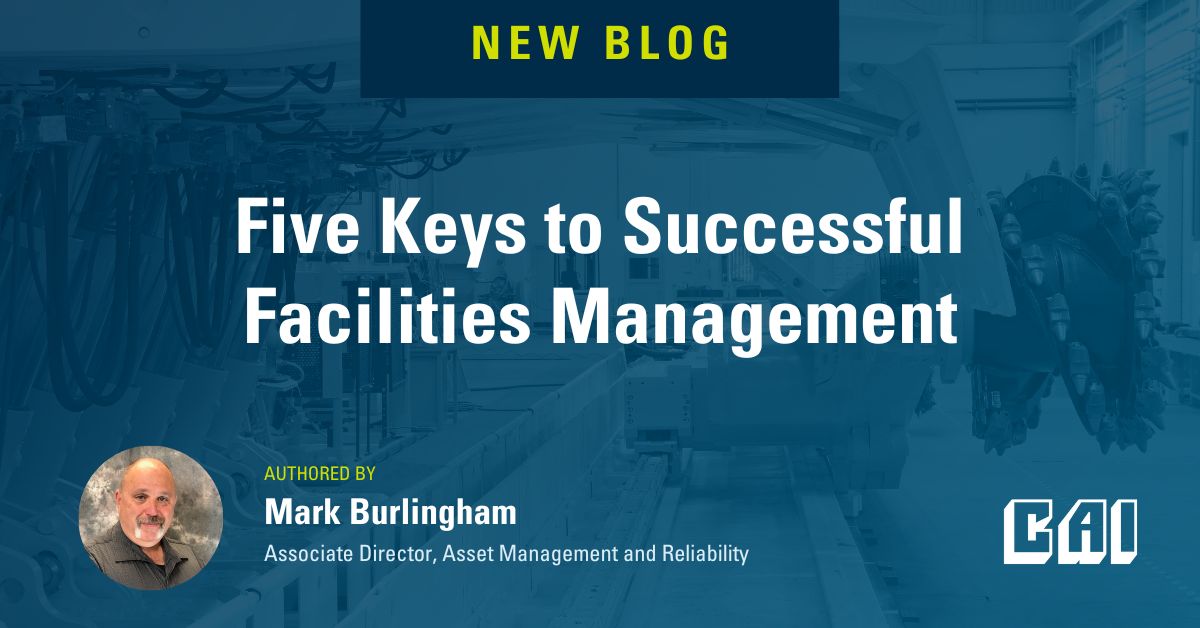
Five Keys to Successful Facilities Management
Facilities Management is a critical aspect of maintaining a safe and efficient workplace. It involves a wide range of tasks, from maintaining the physical infrastructure to managing resources and ensuring a comfortable environment for employees. Below are five key areas where organizations commonly have room to improve their Facilities Management program.
1. Proper use of Preventive Maintenance:
One of the most common areas for facilities management improvement is preventive maintenance optimization. While preventive maintenance is an effective tool, it is often used as a catch-all for all planned maintenance activities. During the investigation of an equipment or system failure, corrective actions often lead to the creation of preventive maintenance activities for issues that cannot easily be prevented. Frequently, these tasks are created to compensate for design issues that should be corrected through re-engineering. Many organizations only address maintenance issues when they become critical, leading to higher repair costs and downtime. It is imperative to understand and optimize all proactive maintenance tasks, including predictive technologies, condition-based maintenance, root cause analysis, and reliability-centered maintenance. The key to using each properly is to address identified potential failures through proper engineering, controls, operations, and, finally, maintenance.
2. Allow the right personnel decision-making authority:
Facilities Managers must be included in decisions that affect the ability to maintain and operate the facility. Facilities personnel should have significant input to decisions. Bringing a facilities expert into the selection process early can greatly influence long-term success. This is especially critical in smaller startup facilities. Once these decisions are made, many are nearly impossible to overcome. They may have been included in corrective/preventive actions from an investigation or after a significant financial stake has already been incurred. Having the correct people involved in the decision and development of these systems is crucial to the effective management of the facility.
3. Take the time to select the correct metrics:
Key performance indicators, or metrics, can be an effective tool for all groups to understand the current operational condition of the facility and how it impacts each group. Operational excellence can be a quick, efficient way to communicate issues and changes in facility plans. Here, the tier process is a routine where the functional areas meet each day or shift and pass information up through progressively higher levels of cross-functional tier meetings. Too often, these systems are built and used, focusing on the process rather than the end results. This should communicate information across groups as well as up and down the management structure; however, often, the focus is on making sure the metrics are all “green,” not asking the tough, “Are we measuring the right thing.” The development of metrics that measure the health of the processes and communications designed to effectively deliver information is essential to the proper operation of the facility.
4. Embrace and effectively implement technology:
Modern facilities management relies on various technologies and software solutions to streamline operations and improve efficiency. Effective use of this technology can significantly enhance the ability to manage facilities. By investing in facility management software, IoT devices, and other technology solutions, along with the proper personnel and training to implement and manage it, a facility can optimize maintenance schedules, monitor equipment health, and make data-driven decisions for better performance. Warning: this requires developing a mature organization that can successfully implement this technology. Ensuring that your staffing, training, and internal processes can support new technology is critical to success. Your technology investment ROI will correlate directly with the company’s maturity level and ability to implement the technology.
5. Effective Asset Management:
Asset management is simply good decision-making at its core and should align with the plans and strategy of the organization. Have a proactive, documented plan that accounts for all facilities stakeholders. Proper management of assets is crucial to the regulatory compliance and long-term success of a facility. Good lifecycle planning can place the facility in a position to effectively execute planned work, respond to equipment failures, and maintain the equipment in a validated state for years to come. Understanding the equipment operation, spare parts requirements (identification, stocking, and reference to routine work), and equipment documentation in the regulated world of pharmaceuticals is also important. A review of internal processes should be done to ask WHY we do something and if it supports the organization’s mission. Then, ask HOW we can most effectively perform that task.
In conclusion, facilities management is a complex field that requires careful planning, attention to detail, and a proactive approach. The five keys mentioned above can significantly improve the efficiency and cost-effectiveness of your facilities management group. By focusing on proper preventive maintenance, professionally trained personnel making informed decisions, building a solid communications plan, embracing technology, and effectively managing assets, you can ensure that your facilities run smoothly, contributing to the overall success of your organization.
Tags: Operational Excellence, asset management, facilities management, maintanence, strategic planning



